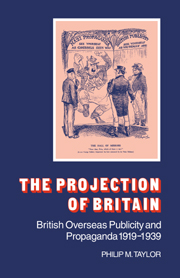Book contents
- Frontmatter
- Contents
- Preface
- Acknowledgements
- Abbreviations
- Introduction
- Part One Publicity and diplomacy, 1919–1939
- Part Two The projection of Britain, 1919–1939
- Part Three Psychological rearmament, 1935–1939
- 5 The BBC foreign-language broadcasts
- 6 The Vansittart Committee for the Co-ordination of British Publicity Abroad
- 7 Propaganda for war
- Conclusion
- Notes
- Select bibliography
- Index
7 - Propaganda for war
Published online by Cambridge University Press: 01 October 2009
- Frontmatter
- Contents
- Preface
- Acknowledgements
- Abbreviations
- Introduction
- Part One Publicity and diplomacy, 1919–1939
- Part Two The projection of Britain, 1919–1939
- Part Three Psychological rearmament, 1935–1939
- 5 The BBC foreign-language broadcasts
- 6 The Vansittart Committee for the Co-ordination of British Publicity Abroad
- 7 Propaganda for war
- Conclusion
- Notes
- Select bibliography
- Index
Summary
In 1914 Britain had entered the First World War almost completely unprepared for the conduct of propaganda in foreign countries. That this was not the case on the outbreak of the Second World War was largely because of developments which occurred between 1935 and 1939.
The rapid growth of the peacetime machinery during this quinquennium, from the foundation of the British Council to the creation of the Industrial Publicity Unit, has already been discussed. These organisations were, however, designed to promote Britain's prestige in a peaceful, albeit troubled, world. It did not automatically follow that they would be called upon to undertake British overseas propaganda in time of war, when an entirely different set of conditions would require different solutions. Moreover, from an organisational point of view, one of the chief lessons to be drawn from the experience of the Great War was that if inter-departmental rivalry, overlapping and inefficiency were to be avoided in any future conflict, it would be advisable to centralise the conduct of all official propaganda under one roof. As the very appointment of the Vansittart Co-ordinating Committee in 1938 revealed, the record of the peacetime agencies was not a good one in this respect. Parallel to, but quite distinct from, the expansion of the peacetime apparatus, a sub-committee of the Committee of Imperial Defence was secretly working out the details for the establishment of a Ministry of Information to take charge of all propaganda – both at home and abroad – in the event of war.
- Type
- Chapter
- Information
- The Projection of BritainBritish Overseas Publicity and Propaganda 1919–1939, pp. 260 - 292Publisher: Cambridge University PressPrint publication year: 1981



